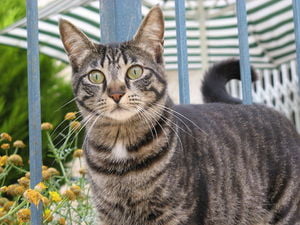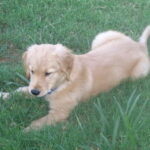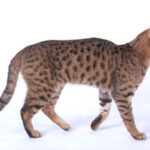Cats with visible stripes, swirls or spots on their bodies are referred to by breeders, owners and cat fanciers, as tabbies. Although some people erroneously assume the tabby cat to be a breed, it in fact describes a type of fur pattern, and can be seen in most breeds of cat, including the wild ancestors of the domestic cat.
There are several different types of tabby pattern, even excluding the complex agouti trait. To simpify the terminology used in the breeding, sale, and showing of cats, a few basic definitions have been laid to describe individual patterns of tabby marking.
The Mackerel Tabby Pattern
The most common tabby pattern in cats is the mackerel pattern, seen in the majority of cats of all colors. Mackerel tabbies’ patterns are defined by their narrow, vertical, continuous stripes that break only on the flanks and stomach (if at all). Most mackerel tabbie cats have a visible “M” shape on their foreheads in a dark color, as well as peppered coloration on their noses.
The Broken Mackerel Tabby Pattern
A variation of the traditional mackerel tabby pattern, broken mackerels look very similar, but have small breaks in their darked stripes. Like the traditional mackerel tabby cat, it usually has a peppered nose and a visible “M” on the forehead, with the only key difference being small, fracture-like breaks in the vertically striped fur pattern.
The Candle-Flame Tabby Pattern
Candle-flame tabby cats, also called braided, are another variation of the classic mackerel tabby pattern. Candle-flame tabby cats have thinner, more tightly joined stripes that weave together to form the illusion of braids or, as the name suggests, candle flames. The pattern is seen mostly in wild-domestic cat hybrids.
The Classic Tabby Pattern
Classic tabby cats have the same “M” on their foreheads as mackerel tabbies, but the fur pattern is differentiated by thicker, bolder swirls rather than stripes. Cats exhibiting the classic tabby pattern have large, thick swirls, often forming bullseye-style patterns on the hind flanks and sides. In classic tabby cats, the legs and tails are often deeply and uniformly banded.
The Modified Classic Tabby Pattern
The Sokoke cat breed is one of only a very few breeds exhibiting the traits of the modified classic tabby pattern. Like the marbled bengal and other wild-looking domestic cats, these classic tabbies have deeply swirled patterns that resemble tree bark in their appearance. Unlike the standard classic tabby, these cats’ bands appear “hollow”, with a dark-colored outline and a light-colored inside.
The Marbled Tabby Pattern
Similar to the modified classic tabby pattern, and another variation of the same, marbled cats take the effect one step further to display deeply varied marbling of the classic tabby coat. In a series of deep swirls and highly varied colors, this coat pattern creates a salt-and-pepper style. Like candle-flame tabbies, marbled tabby cats are almost always descended from wild-domestic cat hybrids.
The Spotted Tabby Pattern
Spotted tabbies are the least common of the three main coat patterns, and cats with the genes are, as the name implies, spotted. While some breeders have suggested that these are not true spots, but rather, cleanly broken-up stripes, the name persists. Some fully domestic cats, such as the Egyptian Mau and the Ocicat, exhibit spotted tabby coats, but the pattern has been elaborated by the introduction of wild genes.
The Rosetted Tabby Pattern
One development that wild hybrids have added to the gene pool of domestic cats is the addition of rosette patterns to other, more traditional tabby cat coats. These cats differ from standard spotted tabbies because their spots are rosettes, or circles, similar to those seen on leopards and jaguars. The Bengal is one breed especially known for the rosette tabby pattern, although it can be seen in other breeds as well, including the Bombay.
Tabby cat patterns can be labeled and categorized into several basic descriptions to enable easy communication between breeders, owners, handlers, and cat fanciers. All variations of this classical, ancient pattern reveal the beauty and soul of the cat, created by thousands of years of evolution and selective breeding.
Source: CFA. Common Cat Colors. Accessed 24 Dec 08.





